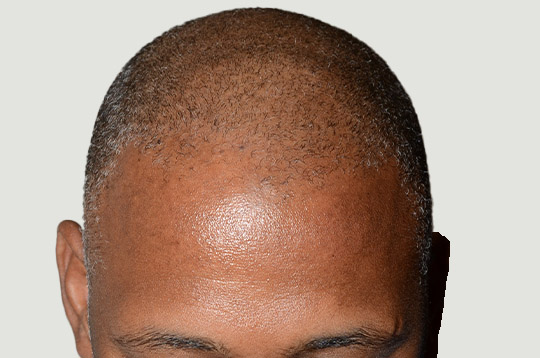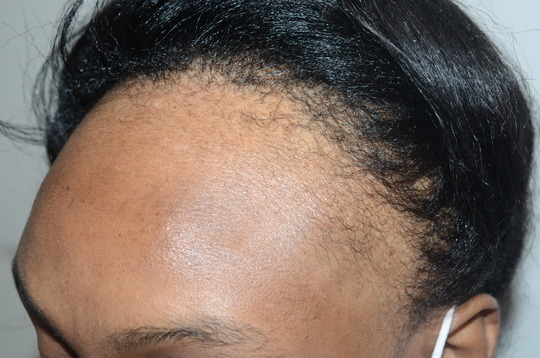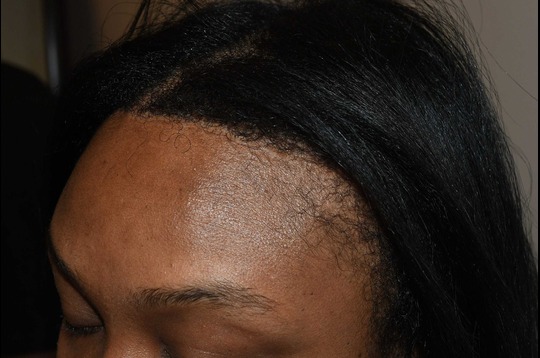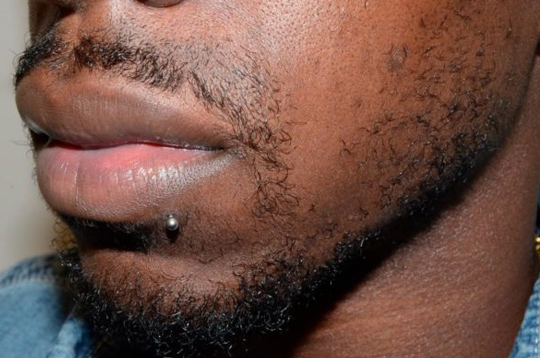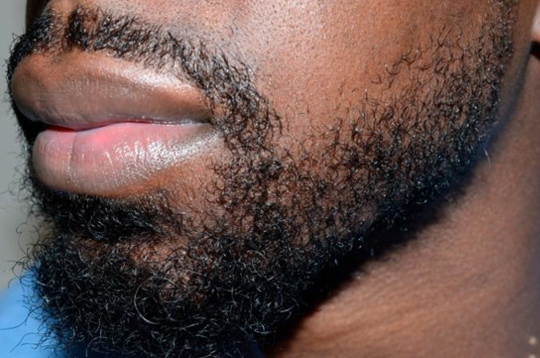Dr. J. Epstein specializes in African American hair transplants and understands the unique challenges patients face, including a high or receding hairline, thinning, traction alopecia, and scarring.
African American Hair Transplants
Bold Beauty in Hair Restoration
Hair loss, clinically known as alopecia, is not exclusive to any one ethnic group or race. Like other ethnicities, men and women of African American and Caribbean descent can experience a range of baldness and hair thinning, which can be a stressful experience, especially when it starts at a relatively young age.
Due to the unique features of African American hair — varying degrees of curl tightness, texture, density, fragility — it can be challenging to accomplish successful hair transplants in black men and women. This is why it’s important that patients seek out an experienced hair transplant surgeon with extensive experience working with black and afro-textured hair.
Dr. J. Epstein and his team have a profound grasp of the most common concerns and challenges that African American patients face when dealing with hair loss, including a high or receding hairline, thinning, traction alopecia, and scarring. At Foundation Aesthetic Hair Restoration, we specialize in African American hair transplants and can diagnose, treat, and restore all ethnic hair types using a selection of cutting-edge hair restoration technologies, including follicular unit extraction (FUE), graft planting, laser and light therapy, micropigmentation, and more.
FUE Hair Transplant Procedure - 4 Days Post-Op
Hairline Lowering Surgery

What Causes African American Hair Loss?
While many of the causes of hair loss in Black patients can be attributed to the same genetic factors as other ethnic groups, African American and Caribbean individuals, particularly females, tend to be more prone to developing balding and hair thinning as a result of prolonged tension in their hairstyling.
Structural Characteristics
Most people with African American and Caribbean ancestry have curly hair, which is structurally different from Caucasian or Asian hair. Whereas other ethnicities tend to have round hair follicles, the hair follicles of Black individuals are asymmetrical, with an elliptical shape and curved bulb. The shape of the hair follicles is what determines whether a person has curly hair or straight hair, and they also act like anchors that hold each strand in place.
Research suggests that irregular or elliptical-shaped follicles have a higher susceptibility to hair breakage compared to round-shaped follicles. This also makes people of African descent more likely to experience slow hair growth, a higher number of knots, and lower hair density.
Stress
High levels of stress increase a person’s risk of developing all kinds of health problems, including hair loss. There are three types of alopecia that can be associated with chronic stress:
Alopecia Areata
An autoimmune disorder that causes hair loss on the scalp, eyebrows, eyelashes, beard, and other parts of the body. We don’t know exactly what causes alopecia areata, but evidence suggests that people with a family history of autoimmune disorders seem to be more likely to develop it. Certain lifestyle factors, including chronic stress, may also trigger alopecia areata in some individuals.
Telogen Effluvium
A form of temporary alopecia characterized by excessive hair shedding following a physiological or environmental shock that causes the hair follicles to “shut down” and stop growing hair. Common causes of telogen effluvium include giving birth, experiencing a physical or psychologically traumatic event, and rapid weight loss.
Trichotillomania
Sometimes known as hair-pulling disorder, trichotillomania is a mental health condition where people have frequent and overwhelming urges to pull out their own hair, resulting in bald spots in the scalp, eyebrows, eyelashes, or other areas of the body. Extreme stress can trigger trichotillomania in some people.
Traction Alopecia
It is estimated that as many as one-third of women of African descent develop traction alopecia, a form of hair loss that results from prolonged use of hairstyles that tug on the hair too tightly, such as cornrows, braids, microbraids, twist, dreadlocks, high ponytails, and weaves or extensions applied to relaxed hair.
Next to genetic pattern hair loss, traction alopecia is perhaps the most commonly diagnosed form of hair loss among people of African and Caribbean descent. It is caused by inflammation of the hair follicles when the hair is being pulled back too hard for too long. And it’s also one of the most common types of female hair loss in general.
Fortunately, traction alopecia can be reversed if caught on time, and there are several hair loss treatments available to promote hair regrowth. You may have traction alopecia if you have one or more of the following symptoms:
- Receding hairline around the forehead, temples or nape of the neck
- Itching
- Redness
- Small white pimples at the base of braids
- A growing number of broken hairs
- Cracked or scarred skin on the scalp
How is African American Hair Loss Treated?
Treatment for African hair loss and thinning depends on several factors, including the type and extent of the hair loss, the health of the current hair, age, and overall health of the patient. At Foundation Aesthetic Hair Restoration, we specialize in African American hair transplants and offer a number of state-of-the-art surgical and non-surgical hair loss procedures and techniques that can yield permanent, natural-looking results backed by a history of thousands of satisfied patients.

Female and Male Pattern Baldness
Also called androgenic alopecia, female or male pattern baldness is a form of hair loss that affects men and women differently. In both cases, this type of hair loss is typically hereditary, but despite its name, women are less likely to go completely bald.
Androgenic alopecia is marked by a shortening of the hair growth phase, known as anagen, and an extended period between the shedding phase and the start of a new growth phase. In other words, the hair sheds for longer and takes longer to grow back.
In male-pattern baldness, hair is commonly lost in a distinct pattern, typically beginning at the temples and forming the characteristic “M” shape as the hairline recedes. In some cases, hair loss is concentrated in the crown region, while in others, there is diffuse thinning throughout the scalp.
In women, the hairline often remains intact; however, the hair tends to thin across the entire scalp, particularly at the top.

Other Health Conditions
Anemia, low thyroid or high testosterone levels, certain medications, rapid weight loss and nutritional deficiencies are common causes of noticeable hair loss. That’s why, before any hair transplant or restoration procedures, Dr. J. Epstein and his team always conduct a thorough medical evaluation, including tests, analyses, and a detailed review of the patient’s medical history to diagnose the precise cause of the hair loss, hair loss patterns, and future implications in order to improve the likelihood of a successful transplant.
In addition, patients of African ethnicity are more prone to developing scarring alopecias. The most significant of these is CCCA, or central centrifugal cicatricial alopecia, a condition characterized by hair loss in the crown region of the scalp, along with inflammation and scarring.
Non-surgical Restorations
In-office, non-surgical hair restoration includes minimally-invasive procedures like light therapy, medications, fat grafting (also known as fat transfer), scalp micropigmentation (SMP), and more. These treatments are safe and effective when performed by an expert in hair restoration.
However, it’s important to note that there are countless African American hair restoration solutions available over-the-counter in the form of supplements, serums, shampoo, oils, hats, and more. Some are even marketed specifically to Black men and women, promising to save money and reverse years of hair loss to no avail.
Unfortunately, the truth is that most of these simply do not work to treat hair loss. The best way to stop or reverse hair loss is to schedule an appointment with a professional that can take the time to assess your unique situation and suggest the most appropriate course of action.

Surgical Restorations
Hair Transplant
Hair transplants are the gold standard of hair restoration, and both men and women – including those seeking African American hair transplants – benefit from traditional hair transplant surgery, with a few special considerations.
Hair transplants to the scalp, beard, and eyebrows are usually performed under local anesthesia with oral sedation. On the morning of your surgical procedure, your doctor will mark the area and design a new hairline with your input and any/or reference images you may have given beforehand. The donor hairs will be harvested one at a time using FUE techniques and placed under the microscope to assure they are the ideal size and contain the desired number of strands.
Once the doctor has created the recipient sites (the most important aesthetic step to determine the pattern, direction, and angulation of growth), the grafts will be placed one at a time, leaving no visible scarring once healed. The use of the smallest possible recipient sites — typically 0.5 to 0.7mm — assures the quickest healing and essentially no scarring. The entire hair transplant procedure takes four to seven, sometimes up to 10 hours to perform.
Follicular Unit Excision or Extraction (FUE)
FUE, or follicular unit excision or extraction, is the technique for harvesting the donor hairs. This involves removing individual grafts containing from one to four hairs and avoiding any linear incision scar, which allows most of our patients to shave their head in the future without any issues.

Before and after 3,200 total FUE grafts.
Eyebrow Transplant
The eyebrows are an important facial feature, and overly thin or completely absent eyebrows can be a problem for some African American patients. The transplant procedure is very delicate, with hairs taken from the scalp requiring perfect placement into half-millimeter incisions.
Hairs must be placed at the correct angle for a natural appearance and to allow them to grow normally after the procedure. The eyebrow transplant procedure ranges from 100 to as many as 400 grafts per side, depending on the existing hair and desired appearance. Note that consideration will be taken as to the curl of the donor hairs; typically, only the softest curled hairs are used for eyebrows.

In this Black patient, the “soft curl” of her hair made it a bit easier to achieve a natural appearance with 650 grafts to the eyebrows.
Forehead Reduction Surgery
Hair transplants for Afro-Caribbean women is one way to lower an overly high or receded hairline. Another highly effective way, provided the area is not receding but rather present at birth (a common ethnic feature in women from certain parts of Africa in particular), is hairline lowering/forehead reduction surgery, also called the surgical hairline advancement (SHA).
This 90-minute procedure performed under anesthesia can bring the hairline forward by an inch or more, with unsurpassed density and instant results. Most patients can go back to their regular activities within a couple of days, and sutures get removed after one week.

Before and five months after hairline lowering/forehead reduction surgery and forehead bone rasping.
Facial Hair Transplant
Facial hair transplants can be a life-changing solution for African American men who struggle with patchy beards or want to enhance their facial hair. The procedure uses the same advanced methods as scalp hair transplants, with individual hairs harvested from the back or sides of the scalp using FUE (Follicular Unit Extraction) techniques. These hairs are then carefully transplanted into the beard or mustache area, ensuring a natural, full look.
The process begins with the doctor marking the desired beard or mustache design based on your preferences and facial structure. Each graft is placed into recipient sites made with precision to ensure the correct angle and direction, providing a natural flow of hair. The entire procedure usually takes between four to eight hours, and the result is a fuller, well-defined facial hairline that appears completely natural, with minimal recovery time. Post-procedure care is simple, and there is virtually no visible scarring due to the small incisions made during graft placement.

Before and After 2000 FUE grafts.
Other Considerations
Some patients are concerned about preserving an intricate hairstyle, weave, or relaxed hair during the procedure. An experienced surgeon can work between these styles, avoiding the need for cutting off locs or braids in most cases. It is recommended that relaxers not be used on the hair for the first month after a procedure, as these harsh chemicals can damage all hair.

Recovering From a Hair Transplant
Recovery from hair transplant surgery is usually quite easy, and patients can go back to normal activities as soon as the day after surgery, except for strenuous exercise, which should be held off until the 6th day. Here’s what you can expect from your hair transplant recovery:
Immediately after surgery
Unlike more invasive methods, you will be able to walk out of our office and go back to your normal life immediately after surgery with the FUE hair transplant technique. You will be given antibiotics and medications to manage what is typically mild discomfort, if any.
Two days after surgery
You may experience some swelling and/or discomfort in the treatment area. Follow your doctor’s recommendations and contact the office if you have any questions or concerns.
One week after surgery
There will be visible signs of the procedure for about a week, with tiny crusts appearing at the site of each graft before falling off. The transplanted hairs fall out a few weeks later but will begin to grow back permanently about four months later.
Two weeks after surgery
At this time the transplanted hair will likely fall off. This is completely normal. You can expect your hair to enter the growth phase in the next few months.
Six to eight months after surgery
By now, you should be seeing noticeable hair growth and thickening in the transplant area. Keep following your doctor’s recommendations regarding washing and styling. You can expect continued hair growth over the next 6 months.
African & Caribbean Ethnic Hair Transplant FAQs
What is the closest ethnic hair transplant clinic to me?
If you live in Miami or nearby, Foundation Aesthetic Hair Restoration is conveniently located at 6280 Sunset Drive, Suite 504, Miami, FL 33143. We offer a variety of treatments for ethnic hair, including African American hair transplants, and address concerns like hair loss, receding hairlines, thinning, traction alopecia, and scarring.
Will I have any scarring after a hair transplant?
In the past, a linear scar following hair transplant was a problem for male African American patients. Now, with the FUE method, this is avoided. Instead of a strip of tissue, follicles are removed individually, resulting in tiny dot scars typically unnoticeable. In a patient with an old linear donor site scar, its appearance can be improved using scar repair, hair transplantation, or SMP or scalp micropigmentation.
Can I choose the shape of my hairline before hair transplant surgery?
Hairline shape and design is an important factor in your overall hair transplant satisfaction, and your surgeon will ask your input on this before the procedure to ensure you are on the same page about your desired hairline. African American hair transplant photos can help give you an idea of the possible hairlines and can serve as points of reference for your consultation.
How much is an African American hair transplant in Miami?
The cost of a hair transplant in Miami will vary depending upon several factors, including the provider you choose, the number of grafts needed, the technique used, and more. On average, the price of a hair transplant surgery in Miami can cost between $5,000 and $20,000, and go as high as $30,000.
What are the risks of hair transplants for African American patients?
Hair transplant surgery is very safe when performed by an expert, but there are always small surgical risks to consider. Rarely, reactions to anesthesia, bleeding, unfavorable scarring, or poor growth of hair follicles can occur. Because of the way the hair grows in African American and Caribbean patients, there is also a small chance for ingrown hairs or folliculitis, which can be easily treated if they occur. A history of keloid scarring doesn’t seem to be a risk factor for transplant complications.
How many grafts will I need?
It depends on your degree of hair loss and your desired results. Typically, because the hairs are curly and achieve greater coverage, fewer grafts will be required compared to patients with straight hair.
ACTUAL PATIENT
Contact Us Today
Start Your
Journey
Have questions? Reach out today
for answers and more information.
